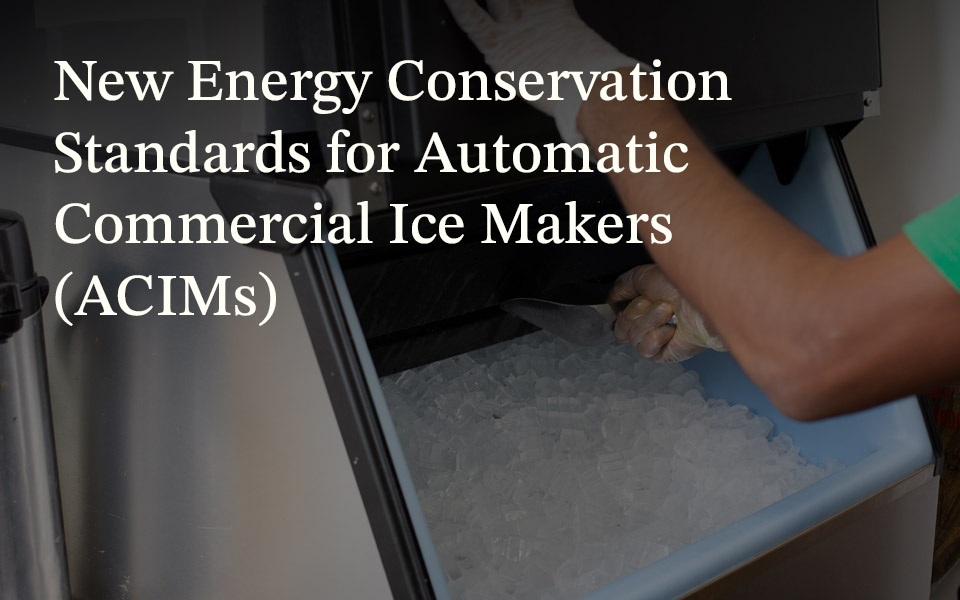I recently conducted an E360 webinar about the Department of Energy’s (DOE) new energy-efficiency standards on walk-in coolers and freezers (WICF). The webinar was presented to help industry stakeholders prepare for compliance by reviewing the ruling’s scope, definitions and potential industry impacts. View an archive of the webinar here and/or read a summary of its key takeaways below.

Ruling overview
On June 3, 2014, the DOE published its final rule on prescribed performance-based standards for WICFs, which specifically apply to the condensing units and unit coolers used in these systems. Then, on July 10, 2017, the DOE issued an update to the ruling and released its minimum efficiency test procedures, which they termed the annual walk-in efficiency factor (AWEF).
AWEF is a metric created by the Air-Conditioning, Heating, and Refrigeration Institute (AHRI) designed to help manufacturers validate compliance. As defined by the AHRI 1250-2009 standard, AWEF minimum efficiency requirements for dedicated condensing units vary per capacity and application (e.g., indoor, outdoor).
Although the compliance date for medium-temperature, dedicated condensing system applications has been in place since 2017, the DOE has established the following enforcement dates for 2020:
-
- 1: for medium-temperature WICF applications
- July 10: for low-temperature WICF applications
Scope and definitions
The scope of the ruling pertains to enclosed WICFs that can be walked into and have a total chilled storage area of less than 3,000 square feet. In addition, the ruling applies only to those condensing units and unit coolers designed to provide one refrigerated load. Products designed and marketed exclusively for medical, scientific or research purposes are excluded from this ruling.
According to the DOE ruling, 32 °F is the point of differentiation between walk-in coolers and freezers. A walk-in cooler is defined as an enclosed storage space refrigerated to temperatures above 32 °F. A walk-in freezer is defined as an enclosed storage space refrigerated to temperatures at or below 32 °F.
The DOE WICF ruling applies to both new and retrofit refrigeration systems, including:
-
- Condensing units that are assembled to construct a new WICF
- Condensing units that are used to replace an existing, previously installed WICF component (retrofit)
- Condensing units used within packaged systems
Important note: While this does mean that condensing units manufactured after the ruling’s enforcement dates must comply, it does not exclude wholesalers and contractors from using and stocking condensing units that were manufactured before the DOE enforcement dates.
Industry impacts
With the DOE enforcement dates quickly approaching, stakeholders throughout the commercial refrigeration industry need to understand the ruling’s potential impacts on their businesses. Of course, this starts with equipment manufacturers that must not only manufacture compliant products, but also demonstrate certification and compliance through the following: registration with the DOE’s Compliance Certification Management System (CCMS) database; proper disclosure in marketing materials; and permanent nameplate marking.
Impacts to other key stakeholders include:
-
- Wholesalers —must be prepared for changing inventories and begin carrying only AWEF-compliant products if they are manufactured after the 2020 enforcement date
- Contractors —must understand that if they replace a condensing unit with one manufactured after the DOE enforcement date, it must be an AWEF-compliant unit
- Design consultants— must be well-versed in the regulatory impacts to advise end users in the selection of energy-compliant, sustainable systems
- End users— need to consider selecting future-proof equipment that aligns with their long-term refrigeration strategies
Regardless of your specific role, Emerson offers additional training, resources and expertise to help you prepare for compliance and understand the impacts of the DOE’s WICF ruling. For more information, please view the webinar archive or download our DOE WICF ruling FAQ document.

Let the Refrigerant Phase-in Begin
Evaluating next-generation commercial refrigerant alternatives in established and emerging...

Reviewing Proposed Energy Efficiency Standards for Ice Machines
Earlier this year, the Department of Energy (DOE) published a notice of proposed rulemaking (NOPR)...

CO2 as a Refrigerant — Criteria for Choosing Refrigerants
This is post two of CO2 as a Refrigerant, a blog series covering the fundamental considerations...
